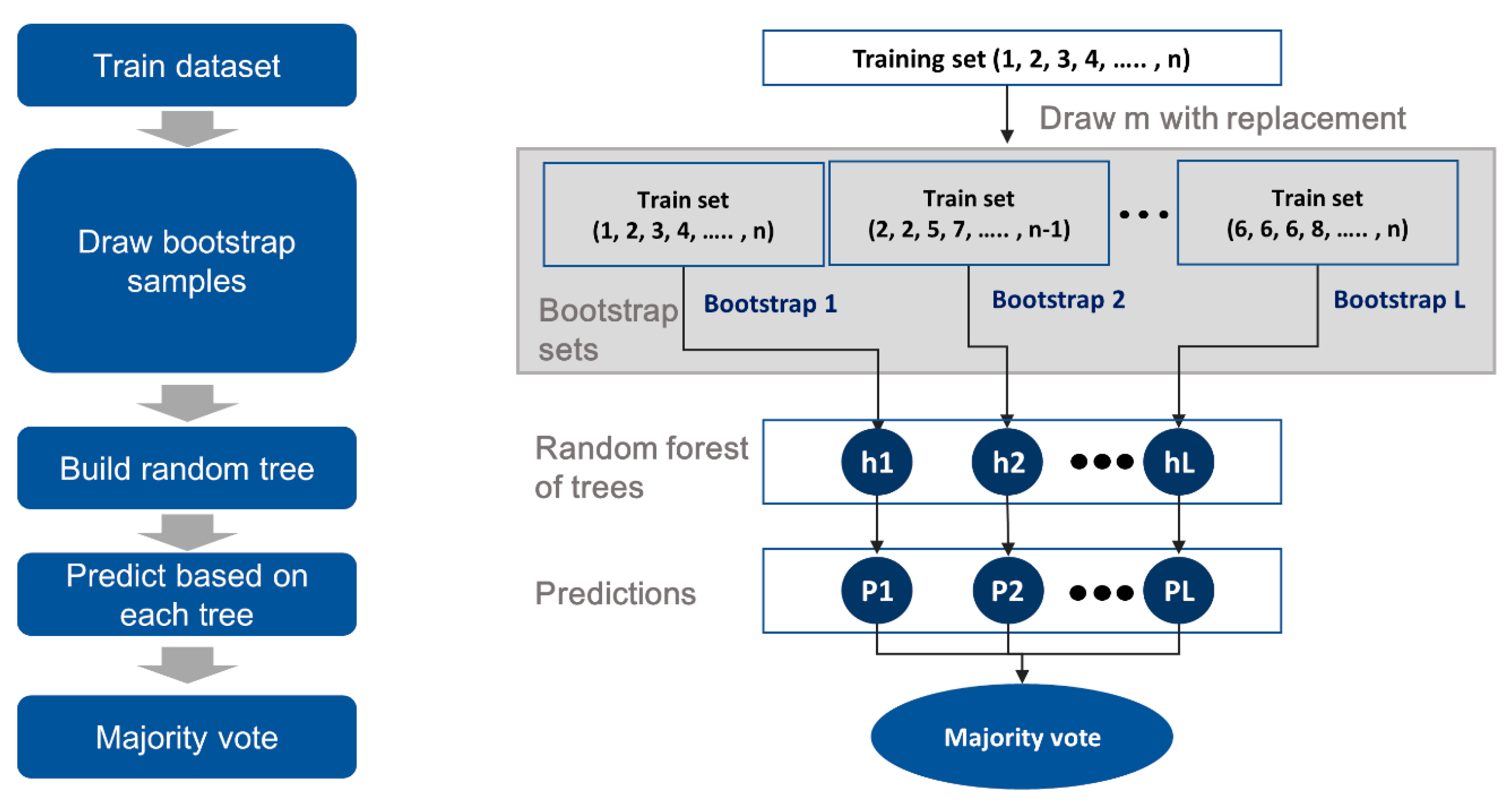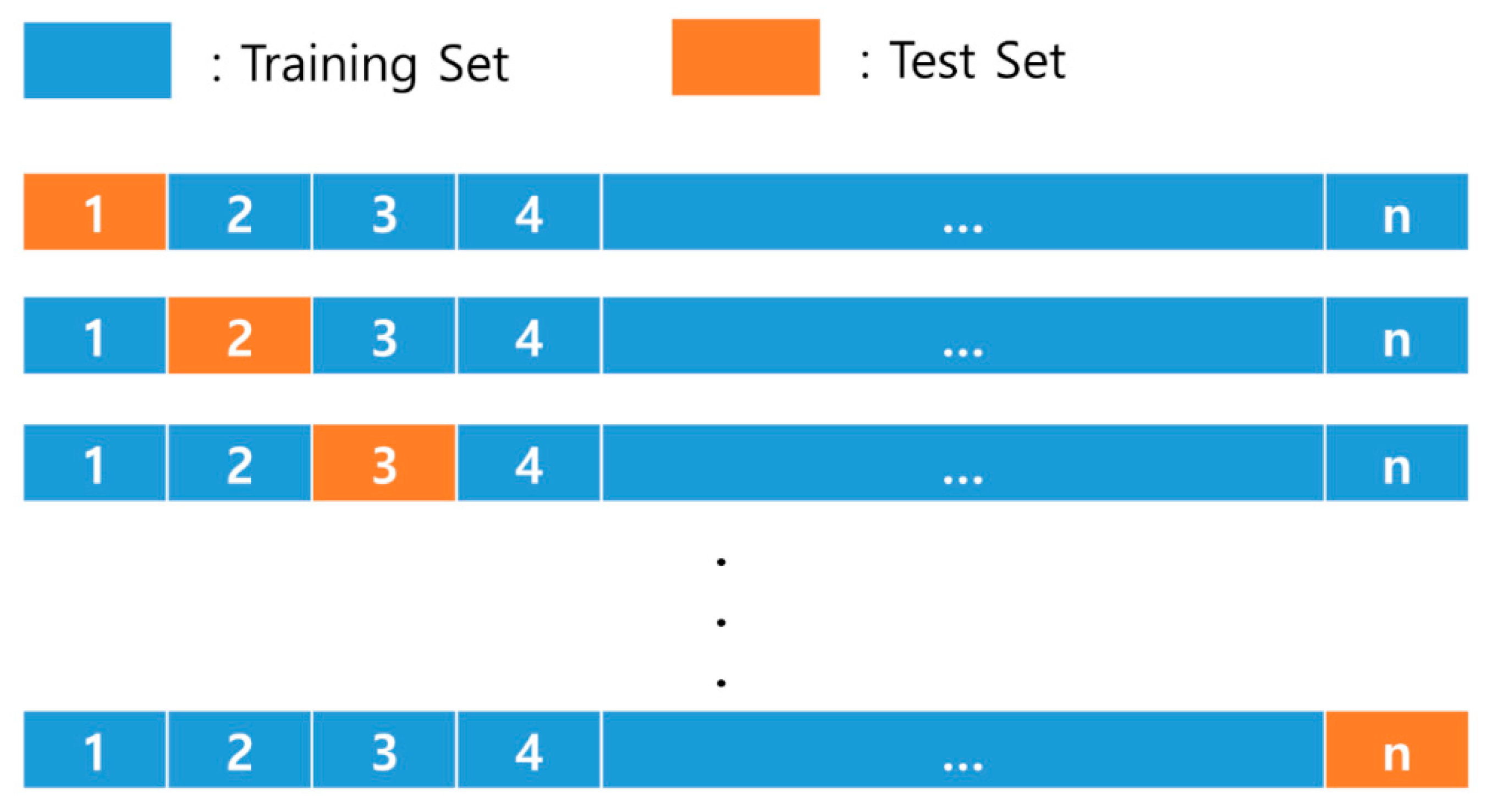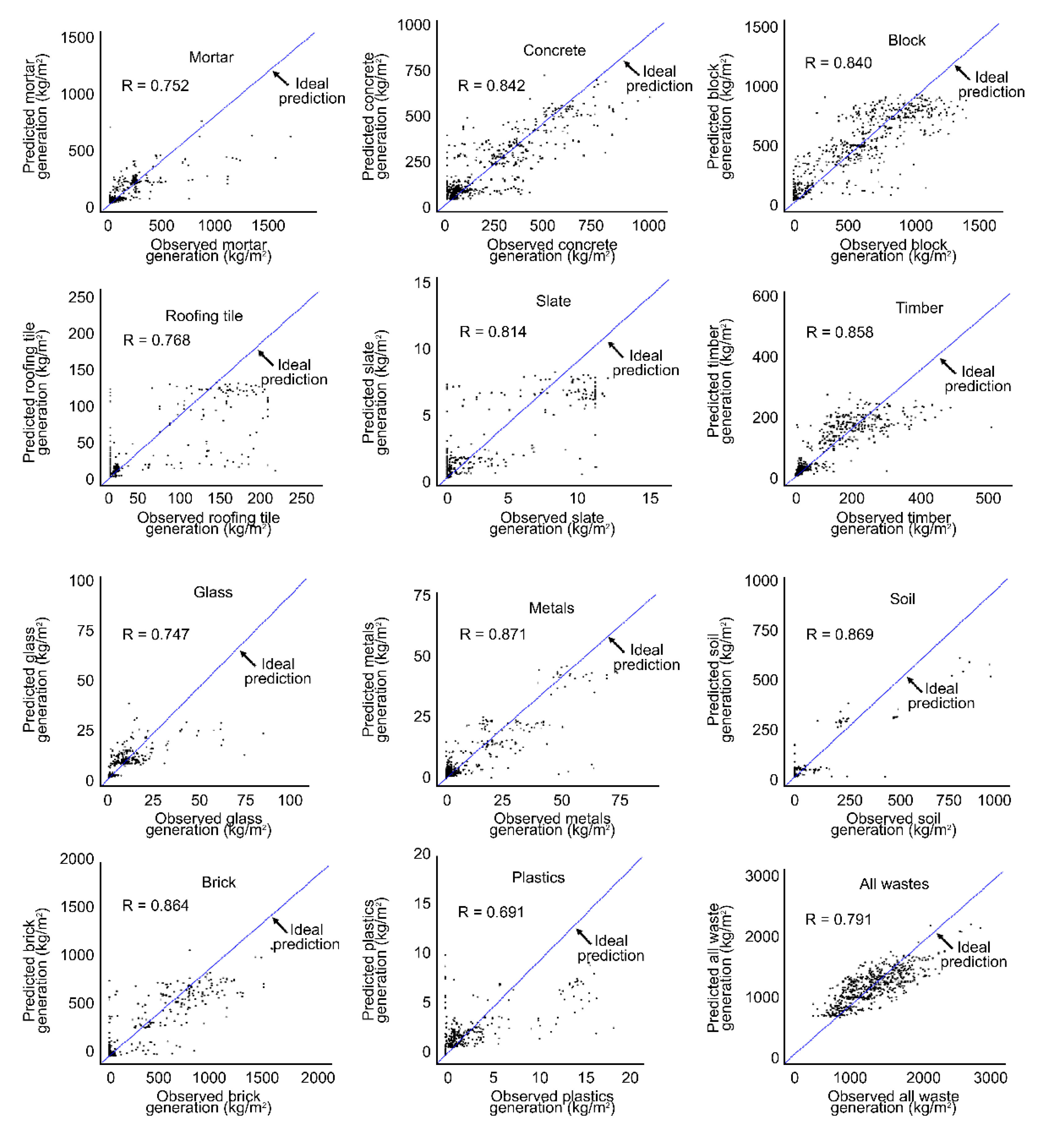Development of a Prediction Model for Demolition Waste Generation Using a Random Forest Algorithm Based on Small DataSets
Abstract
1. Introduction
2. Materials and Methods
2.1. Random Forest Algorithm
2.2. Feature Selection Methods
2.3. Leave-One-Out Cross-Validation
2.4. Limitations of LOOCV and the Results of the RF Model in this Study
3. Development of a DW Prediction Model
3.1. Overview of the RF Model Development Method for Predicting DW Generation
3.2. Data Preprocessing and Input Variable Selection
3.3. Model Verification and Performance Evaluation
4. Results
4.1. Results of Input Variable Selection
4.2. Prediction Performance of the Developed RF Model
4.3. Discussion
5. Conclusions
- First, RF is an adequate machine learning algorithm for a small dataset consisting of categorical data. The RF model developed in this study demonstrated a relatively high prediction performance with a high correlation coefficient R of 0.691–0.871 between the values predicted by the models and the observed values.
- Second, the input variables by the DW type deduced from the embedded method of input variable selection, RF-RFE, were applied to the RF model. This implies that, even with a small dataset, an adequate prediction model can be developed. Consequently, we obtained a high prediction performance using three (for mortar) of five (for the rest of the DW types) input variables, apart from concrete (for which six input variables were used).
- Lastly, the results of this study demonstrated a similar pattern for predicted values and observed values from 11 RF models by the DW type and one RF model for a building, including all DW types. In conclusion, this study proposed an RF model that can improve the prediction performance using a small dataset of categorical data.
Author Contributions
Funding
Conflicts of Interest
Abbreviations
| AI | artificial intelligence |
| C&D | construction and demolition |
| RF | random forest |
| DW | demolition waste |
| GRC | generation rate calculation |
| GFA | gross floor area |
| ANN | artificial neural network |
| SVM | support vector machine |
| LR | linear regression |
| DT | decision tree |
| GA | genetic algorithm |
| LOOCV | leave-one-out cross-validation |
| REF | recursive feature elimination |
References
- Llatas, C. A model for quantifying construction waste in projects according to the European waste list. Waste Manag. 2011, 31, 1261–1276. [Google Scholar] [CrossRef]
- Li, J.; Ding, Z.; Mi, X.; Wang, J. A model for estimating construction waste generation index for building project in China. Resour. Conserv. Recycl. 2013, 74, 20–26. [Google Scholar] [CrossRef]
- Wang, J.; Li, Z.; Vivian Tam, W.Y. Identifying best design strategies for construction waste minimization. J. Clean. Prod. 2015, 92, 237–247. [Google Scholar] [CrossRef]
- Bernardo, M.; Gomes, M.C.; de Brito, J. Demolition waste generation for development of a regional management chain model. Waste Manag. 2016, 49, 156–169. [Google Scholar] [CrossRef]
- Butera, S.; Christensen, T.H.; Astrup, T.F. Composition and leaching of construction and demolition waste: Inorganic elements and organic compounds. J. Hazard. Mater. 2014, 276, 302–311. [Google Scholar] [CrossRef]
- Lu, W.; Yuan, H.; Li, J.; Hao, J.J.; Mi, X.; Ding, Z. An empirical investigation of construction and demolition waste generation rates in Shenzhen city, South China. Waste Manag. 2011, 31, 680–687. [Google Scholar] [CrossRef] [PubMed]
- Martínez, E.; Nuñez, Y.; Sobaberas, E. End of life of buildings: Three alternatives, two scenarios. A case study. Int. J. Life Cycle Assess. 2013, 18, 1082–1088. [Google Scholar] [CrossRef]
- Wu, Z.; Yu, A.T.W.; Shen, L.; Liu, G. Quantifying construction and demolition waste: An analytical review. Waste Manag. 2014, 34, 1683–1692. [Google Scholar] [CrossRef]
- Gómez-Soberón, J.M.; Saldaña-Márquez, H.; Gámez-García, D.C.; Gómez-Soberón, M.C.; Arredondo-Rea, S.P.; Corral-Higuera, R. A Comparative Study of Indoor Pavements Waste Generation during Construction through Simulation Tool. Int. J. Sustain. Energy Dev. 2016, 5, 243–251. [Google Scholar]
- Oliver, C.L.; Ramírez, L.C.; Fuertes, R.H. Una aproximación metodológica a la verificación en obra de la cuantificación de residuos de construcción en Andalucía. In Proceedings of the SB10mad Sustainable Building Conference, Madrid, Spain, 28–30 April 2010; pp. 1–12. [Google Scholar]
- Coelho, A.; de Brito, J. Distribution of materials in construction and demolition waste in Portugal. Waste Manag. Res. 2011, 29, 843–853. [Google Scholar] [CrossRef]
- Lage, I.M.; Abella, F.M.; Herrero, C.V.; Ordonez, J.L.P. Estimation of the annual production and composition of C&D Debris in Galicia (Spain). Waste Manag. 2010, 30, 636–645. [Google Scholar]
- Zhao, W.; Ren, H.; Rotter, V.S. A system dynamics model for evaluating the alternative of type in construction and demolition waste recycling center—The case of Chongqing, China. Resour. Conserv. Recycl. 2011, 55, 933–944. [Google Scholar] [CrossRef]
- Kleemann, F.; Lederer, J.; Aschenbrenner, P.; Rechberger, H.; Fellner, J. A method for determining buildings’ material composition prior to demolition. Build. Res. Inf. 2016, 1, 51–62. [Google Scholar] [CrossRef]
- Abdallah, M.; Talib, M.A.; Feroz, S.; Nasir, Q.; Abdalla, H.; Mahfood, B. Artificial intelligence applications in solid waste management: A systematic research review. Waste Manag. 2020, 109, 231–246. [Google Scholar] [CrossRef]
- Coskuner, G.; Jassim, M.S.; Zontul, M.; Karateke, S. Application of artificial intelligence neural network modeling to predict the generation of domestic, commercial and construction wastes. Waste Manag. Res. 2020. [Google Scholar] [CrossRef]
- Golbaz, S.; Nabizadeh, R.; Sajadi, H.S. Comparative study of predicting hospital solid waste generation using multiple linear regression and artificial intelligence. J. Environ. Health Sci. Eng. 2019, 17, 41–51. [Google Scholar] [CrossRef]
- Noori, R.; Karbassi, A.; Sabahi, M.S. Evaluation of PCA and Gamma test techniques on ANN operation for weekly solid waste prediction. J. Environ. Manag. 2010, 91, 767–771. [Google Scholar] [CrossRef]
- Song, Y.; Wang, Y.; Liu, F.; Zhang, Y. Development of a hybrid model to predict construction and demolition waste: China as a case study. Waste Manag. 2016, 59, 351–361. [Google Scholar] [CrossRef]
- Abbasi, M.; Abduli, M.A.; Omidvar, B.; Baghvand, A. Forecasting municipal solid waste generation by hybrid support vector machine and partial least square model. Int. J. Environ. Res. 2013, 7, 27–38. [Google Scholar]
- Kumar, A.; Samadder, S.R.; Kumar, N.; Singh, C. Estimation of the generation rate of different types of plastic wastes and possible revenue recovery from informal recycling. Waste Manag. 2018, 79, 781–790. [Google Scholar] [CrossRef]
- Abdoli, M.A.; Nezhad, M.F.; Sede, R.S.; Behboudian, S. Longterm forecasting of solid waste generation by the artificial neural networks. Environ. Prog. Sustain. Energy 2011, 31, 628–636. [Google Scholar] [CrossRef]
- Azadi, S.; Karimi-jashni, A. Verifying the performance of artificial neural network and multiple linear regression in predicting the mean seasonal municipal solid waste generation rate: A case study of Fars province, Iran. Waste Manag. 2015, 48, 14–23. [Google Scholar] [CrossRef] [PubMed]
- Chhay, L.; Reyad, M.A.H.; Suy, R.; Islam, M.R.; Mian, M.M. Municipal solid waste generation in China: Influencing factor analysis and multi-model forecasting. J. Mater. Cycles Waste Manag. 2018, 20, 1761–1770. [Google Scholar] [CrossRef]
- Cha, G.-W.; Kim, Y.-C.; Moon, H.J.; Hong, W.-H. New approach for forecasting demolition waste generation using chi-squared automatic interaction detection (CHAID) method. J. Clean. Prod. 2017, 168, 375–385. [Google Scholar] [CrossRef]
- Huang, R.; Yeh, L.; Chen, H.; Lin, J.; Chen, P.; Sung, P.; Yau, J. Estimation of construction waste generation and management in Taiwan. Adv. Mater. Res. 2011, 243–249, 6292–6295. [Google Scholar] [CrossRef]
- Kannangara, M.; Dua, R.; Ahmadi, L.; Bensebaa, F. Modeling and prediction of regional municipal solid waste generation and diversion in Canada using machine learning approaches. Waste Manag. 2017, 74, 3–15. [Google Scholar] [CrossRef]
- Andersen, F.M.; Larsen, H.; Skovgaard, M.; Moll, S.; Isoard, S. A European model for waste and material flows. Resour. Conserv. Recycl. 2007, 49, 421–435. [Google Scholar] [CrossRef]
- Banias, G.; Achillas, C.; Vlachokostas, C.; Moussiopoulos, N.; Papaioannou, I. A web-based decision support system for the optimal management of construction and demolition waste. Waste Manag. 2011, 31, 2497–2502. [Google Scholar] [CrossRef]
- Chen, X.; Lu, W. Identifying factors influencing demolition waste generation in Hong Kong. J. Clean. Prod. 2017, 141, 799–811. [Google Scholar] [CrossRef]
- Cha, G.W.; Moon, H.J.; Kim, Y.C.; Hong, W.H.; Jeon, G.Y.; Yoon, Y.R.; Hwang, C.H.; Hwang, J.H. Evaluating recycling potential of demolition waste considering building structure types: A study in South Korea. J. Clean. Prod. 2020, 256, 120385. [Google Scholar] [CrossRef]
- Cochran, K.; Townsend, T.; Reinhart, D.; Heck, H. Estimation of regional building-related C&D debris generation and composition: Case study for Florida, US. Waste Manag. 2007, 7, 921–931. [Google Scholar]
- Raschka, S. Model evaluation, model selection, and algorithm selection in machine learning. Comput. Res. Repos. 2018, 1811, 12808. [Google Scholar]
- Jiang, Y.; Lin, J.; Cukic, B.; Menzies, T. Variance analysis in software fault prediction models. In Proceedings of the ISSRE’09: 20th IEEE international Conference on Software Reliability Engineering, Bengaluru, India, 16–19 November 2009; pp. 99–108. [Google Scholar]
- Breiman, L. Random forests. Mach. Learn. 2001, 45, 5–32. [Google Scholar] [CrossRef]
- Ali, J.; Khan, R.; Ahmad, N.; Maqsood, I. Random forests and decision trees. Int. J. Comput. Sci. Issues 2012, 9, 272–278. [Google Scholar]
- Loupe, G. Understanding Random Forests: From Theory to Practice. Ph.D. Thesis, University of Liège, Liège, Belgium, 2014. [Google Scholar]
- Hastie, T.; Tibshirani, R.; Friedman, J. The Elements of Statistical Learning: Data Mining, Inference, and Prediction, 2nd ed.; Springer: New York, NY, USA, 2009. [Google Scholar]
- Huang, J.; Li, Y.F.; Xie, M. An empirical analysis of data preprocesing for machine learning-based software cost estimation. Inform. Softw. Technol. 2015, 67, 108–127. [Google Scholar] [CrossRef]
- Guyon, I.; Elisef, A. An introduction to variable and feature selection. J. Mach. Learn. Res. 2003, 3, 157–182. [Google Scholar]
- Yan, K.; Zhang, D. Feature selection and analysis on correlated gas sensor data with recursive feature elimination. Sens. Actuators B Chem. 2015, 212, 353–363. [Google Scholar] [CrossRef]
- Wong, T.T. Performance evaluation of classification algorithms by k-fold and leave-one-out cross validation. Pattern Recognit. 2015, 48, 2839–2846. [Google Scholar] [CrossRef]
- Shao, Z.; Meng, J.E. Efficient Leave-One-Out Cross-Validation-based Regularized Extreme Learning Machine. Neurocomputing 2016, 194, 260–270. [Google Scholar] [CrossRef]
- Qi, C.; Fourie, A.; Chen, Q.; Tang, X.; Zhang, Q.; Gao, R. Data-driven modelling of the flocculation process on mineral processing tailings treatment. J. Clean. Prod. 2018, 196, 505–516. [Google Scholar] [CrossRef]
- Han, T.; Siddique, A.; Khayat, K.; Huang, J.; Kumar, A. An ensemble machine learning approach for prediction and optimization of modulus of elasticity of recycled aggregate concrete. Constr. Build. Mater. 2020, 244, 118271. [Google Scholar] [CrossRef]
- Johnson, N.E.; Ianiuk, O.; Cazap, D.; Liu, L.; Starobin, D.; Dobler, G.; Ghandehari, M. Patterns of waste generation: A gradient boosting model for short-term waste prediction in New York City. Waste Manag. 2017, 62, 3–11. [Google Scholar] [CrossRef] [PubMed]
- Noori, R.; Abdoli, M.A.; Ghasrodashti, A.A.; Ghazizade, M.J. Prediction of municipal solid waste generation with combination of support vector machine and principal component analysis: A case study of Mashhad. Environ. Prog. Sustain. Energy 2009, 28, 249–258. [Google Scholar] [CrossRef]





| Variables Type | Description | ||
|---|---|---|---|
| Independent variables type | Nominal variable | Region | Region A is assigned a scale number of 1, and regions B and C are 2 and 3, respectively |
| Building use | The scale number is 1 for only residential, and the scale numbers for commercial/residential and only commercial are 2, 3, respectively | ||
| Building structure | Reinforced concrete structure is assigned a scale number of 1, and masonry and wooden structures are 2 and 3, respectively | ||
| Wall material | The scale number for the reinforced concrete wall is 1, the brick wall is 2, the block wall is 3, and the wall made of soil is 4. | ||
| Roofing material | The scale number for the slab is 1, the slab and roofing tile is 2, the roof with asbestos is 3, and the roofing tile is 4. | ||
| Continuous variable | gross floor area (GFA) (m2) | Numeric variable | |
| Dependent variable | Continuous variable | Waste generation (kg/m2) | Numeric variable |
| Waste Type | Number of Variables in the Variable Set | Selected Features (the Top 3 Variables Out of 3) | |||||||||||
|---|---|---|---|---|---|---|---|---|---|---|---|---|---|
| Mortar | 1 | 2 | 3 | ● | 4 | 5 | 6 | R, S, A | |||||
| Concrete | 1 | 2 | 3 | 4 | 5 | 6 | ● | RM, R, S, WM, A, U | |||||
| Block | 1 | 2 | 3 | 4 | 5 | ● | 6 | WM, R, S, A, U | |||||
| Brick | 1 | 2 | 3 | 4 | 5 | ● | 6 | WM, RM, R, A, S | |||||
| Timber | 1 | 2 | 3 | 4 | 5 | ● | 6 | R, RM, A, S, U | |||||
| Slate | 1 | 2 | 3 | 4 | 5 | ● | 6 | RM, R, WM, A, S | |||||
| Roofing tile | 1 | 2 | 3 | 4 | 5 | ● | 6 | R, RM, A, WM, S | |||||
| Plastic | 1 | 2 | 3 | 4 | 5 | ● | 6 | R, S, U, RM, WM | |||||
| Glass | 1 | 2 | 3 | 4 | 5 | ● | 6 | R, A, WM, U, S | |||||
| Metal | 1 | 2 | 3 | 4 | 5 | ● | 6 | R, U, RM, WM, S | |||||
| Soil | 1 | 2 | 3 | 4 | 5 | ● | 6 | WM, R, S, A, U | |||||
| N | RF Model by Waste Type | Statistical Metrics | |
|---|---|---|---|
| R | R2 | ||
| 1 | Mortar | 0.752 | 0.561 |
| 2 | Concrete | 0.842 | 0.707 |
| 3 | Block | 0.840 | 0.704 |
| 4 | Brick | 0.864 | 0.745 |
| 5 | Timber | 0.858 | 0.735 |
| 6 | Slate | 0.814 | 0.659 |
| 7 | Roofing tile | 0.768 | 0.583 |
| 8 | Plastic | 0.691 | 0.568 |
| 9 | Glass | 0.747 | 0.554 |
| 10 | Metal | 0.871 | 0.755 |
| 11 | Soil | 0.869 | 0.800 |
| 12 | All wastes | 0.791 | 0.615 |
© 2020 by the authors. Licensee MDPI, Basel, Switzerland. This article is an open access article distributed under the terms and conditions of the Creative Commons Attribution (CC BY) license (http://creativecommons.org/licenses/by/4.0/).
Share and Cite
Cha, G.-W.; Moon, H.J.; Kim, Y.-M.; Hong, W.-H.; Hwang, J.-H.; Park, W.-J.; Kim, Y.-C. Development of a Prediction Model for Demolition Waste Generation Using a Random Forest Algorithm Based on Small DataSets. Int. J. Environ. Res. Public Health 2020, 17, 6997. https://doi.org/10.3390/ijerph17196997
Cha G-W, Moon HJ, Kim Y-M, Hong W-H, Hwang J-H, Park W-J, Kim Y-C. Development of a Prediction Model for Demolition Waste Generation Using a Random Forest Algorithm Based on Small DataSets. International Journal of Environmental Research and Public Health. 2020; 17(19):6997. https://doi.org/10.3390/ijerph17196997
Chicago/Turabian StyleCha, Gi-Wook, Hyeun Jun Moon, Young-Min Kim, Won-Hwa Hong, Jung-Ha Hwang, Won-Jun Park, and Young-Chan Kim. 2020. "Development of a Prediction Model for Demolition Waste Generation Using a Random Forest Algorithm Based on Small DataSets" International Journal of Environmental Research and Public Health 17, no. 19: 6997. https://doi.org/10.3390/ijerph17196997
APA StyleCha, G.-W., Moon, H. J., Kim, Y.-M., Hong, W.-H., Hwang, J.-H., Park, W.-J., & Kim, Y.-C. (2020). Development of a Prediction Model for Demolition Waste Generation Using a Random Forest Algorithm Based on Small DataSets. International Journal of Environmental Research and Public Health, 17(19), 6997. https://doi.org/10.3390/ijerph17196997






